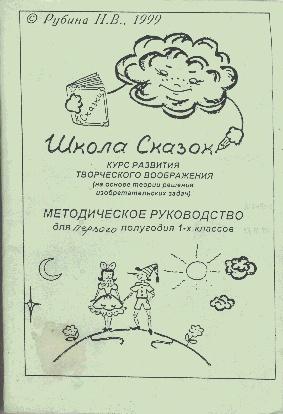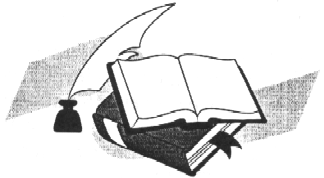Course of Creative Imagination Development (CID), 1st Grade, 1st Semester,
Methodical Guide-Book
English translation by Irina Dolina (Tokyo, Japan) May 23, 2000
Technical Editing by Toru Nakagawa (Osaka Gakuin Univ.) July 16, 2000
List of posting in this Home Page:
| Jan. 30, 2001 | 1st Grade/1st Semester "Fairy Tales School" | Preface, Intro., Topic 1-2 | Guide-Book | Workbook |
| Feb. 28, 2001 | 1st Grade/1st Semester "Fairy Tales School" | Topics 3, 4, 5, 6, 7 (Finish) | Guide-Book | Workbook |
Editor's Note:
Please refer to the Editor's Preface (by T. Nakagawa) and the Author's
Introduction (by N. V. Rubina) on the top page of this Course textbook
series.
| Top of this page | Contents | Front Cover | Invitation (Preface) | Symbol marks | Weekly Topic Planning | CID Course Top Page |
Contents of the CID Course, 1st
Grade, 1st Semester Course
Top Page:
| Book Title;
Grade/Semester |
Contents | Guide-
Book |
Work-
book |
Posted
date |
| "Fairy Tales School"
1st Grade,
|
Preface & Introduction to the Course | Jan. 30,
2001 |
||
| Introduction at the Class | Jan. 30,
2001 |
|||
| 1. What does this or that consists of?
(System is a whole, consisting of parts) |
Jan. 30,
2001 |
|||
| 2. Where is this or that located?
(System - a part of a super-system) |
Jan. 30,
2001 |
|||
| 3. How feels this or that? How seems this or that?
(Properties of the systems) |
Feb. 28,
2001 |
|||
| 4. How to find out?
(Organs of Perception) |
Feb. 28,
2001 |
|||
| 5. What can one do and why?
(Functions of the systems) |
Feb. 28,
2001 |
|||
| 6. What was in the past and what will be in the future?
(Changing systems in time) |
Feb. 28,
2001 |
|||
| 7. Glass City | Feb. 28,
2001 |
(C) N.V.Rubina,
I. Dolina, T. Nakagawa, 2001
Fairy Tales School
Course
of Creative Imagination Development (CID)
(Based on Theory of Inventive Problem Solving
(TRIZ))
METHODICAL GUIDE-BOOK
First Grade, First Semester
Natalia V. Rubina
 |
 |

Fairy Tales School
Course
of Creative Imagination Development (CID)
(Based on Theory of Inventive Problem Solving
(TRIZ))
METHODICAL GUIDE-BOOK
First Grade, First
Semester

Natalia V. Rubina
Petrozavodsk 1999
English Translation by Irina Dolina, May 23, 2000
Technical Editing by Toru Nakagawa, July 9, 2000 and Feb. 28, 2001
The program of the CID course was elaborated and defined in Petrozavodsk in 1996. Six workbooks with special methodological recommendations (for each semester) were worked out. The program and all the methodological material were probated on the basis of the "TRIZ Laboratory" at the Petrozavodsk School #17.
This pamphlet introduces
the methodological instructions for the first semester of the CID first
grade ("The Fairy Tales School").
"The Fairy Tales School". Creative Imagination Development Course for the elementary school (The first semester of the first grade). Methodological instructions.
Reprints and distribution only by author's permission.
 |
INVITATION
to A FAIRY TALE
(instead of Introduction) |
Every
time, getting ready to teach CID class, I expect some unusual, new experience
from each class, each group, where I teach. And my expectations
are justified: new riddles, proverbs, tales, peculiar questions - all this
make CID classes look like a little meeting with a Wonder world.
How is this Wonder world born? What does it consist of?
When I began my work six years ago, I was feeling like a pioneer, discovering new mysterious worlds, when the whole previous experience, education, skills of the pedagogical work were being structured in a certain system of communication with children, trips with them to the world of creativity.
The first step in this system was "Program for the Course of Creative Imagination Developing (CID) for the Elementary School" (1994-1995 academic year). In this book the CID course is prepared for 1-3 grades. The main aims and trends of the CID course were marked out.
"The Program..." is a route along which our trip will proceed. Good equipment is necessary . For the work in class "Workbooks" were elaborated: "Fairy Tales School" - for the first grade, "Fantasy City" - for the second grade, "Planet of the Unsolved Mysteries" - for the third grade (1997-1998 academic year). It is a kind of a diary, that each student writes while traveling with the teacher and the characters of the Workbook around the Fantasy world.
The teacher of the CID classes has a difficult task - he must become a reliable guide in the world of Creativity, he must provide that original creative ideas, a search for the creative problems and solving them should become for the students an everyday necessity. Working out an active stand in life, a stand of a fighter, a creative personality in the course of CID lessons- seems the most important aim of the whole course.
"Methodical Guide
to CID Course" ( first part of which you are holding in your hands) contains
detailed recommendations for conducting CID classes. There are 6
similar parts - two for each class (for first and second semesters).
During your teaching experience you will, certainly, add your own zest
to each lesson. The special charm of the CID classes is in the fact
that these lessons never repeat themselves exactly, not a single lesson
resembles the other one. During CID classes your hobbies, interests of
your students may be reflected. Any exercise, game, psychological riddle
will be more interesting if you develop and extend it. Create together
with the kids!
I know by my own experience how important is the lesson pattern for the preparation work. The pattern itself might be very simple, however, the more complete it is, the more certain you are not to miss anything..
Here is one of the possible patterns of the CID class.
1. Warming-up:
- activities on coordination, rhythm plus a patter,
- activities for the fingers plus a patter
- activities on attention
- matching incompatible
2. Homework check-up
3. Introduction to the lesson ("yes-no" questions, a trick, a riddle)
4. New topic (plot games)
5. Psychotechnical games.
6. Activities on developing speaking skills or designing a product of a creative thinking
7. Sum up.
Of course, following
the pattern is not always possible, sometimes kid's fantasy comes out of
the frames of any scheme. Nevertheless modeling a lesson according
to a pattern makes your work more interesting and at the same time makes
it easier to get prepared.
This work is an invitation to Creativity, to conducting your classes, to elaborating your own course. Any lesson will be more interesting, if creative activities are introduced in it. Therefore besides conducting separate classes on CID course, the activities, offered in this course, may be used at any other lesson. However, following two methodological trends simultaniously: - a trend of developing creative abilities and a trend of lining up the data on a major subject, - in this case may present difficulties for a teacher.
The author expresses her deep gratitude to I. N. Murashkowska, A. A. Nesterenko, M. S. Gafitulin, M. S. Rubin, I. L. Vikentyev, N. N. Khomenko, V. I. Timohov, S. V. Sychov and to other TRIZ experts, whose works have helped in elaborating CID course. And of course the assistance of the students of 1-3 grade of Petrozavodsk school #17 is priceless. Thank you very much, my little magicians.
Send your remarks, proposals and orders for purchasing workbooks and methodological guides on CID at the following address; 185014, Petrozavodsk, mail box 8, OO "TRIZ- Karelia", to N. V. Rubina.
For better
perception the following symbols are used in the methodical guide-book:
 |
- problems. For the first grade simple problems demanding answers "yes-no" are used. The major notions of the methods of solving problems are studied in the second and third grades. That is why the most suitable form for solving creative problems is a game "yes-no". The rules of the game are not difficult. After the problem is introduced the kids start to look for the solution by asking questions to which the teacher replies "yes" or "no". The aim of the game is to find a solution by asking as many questions as possible. |
 |
- activities. During these activities it is important that the kids understand how this or that notion may be used for solving the problems, for obtaining new ideas, etc. |
 |
- psychotechnical games. This is a specific part of the lesson. Kids may relax a little and turn to their inner world, the world of a child's fantasy. It goes without saying how important is the atmosphere of trust, friendliness in your small community. |
 |
- speech developing activities. We all know very well how easy to speak with a person, who can ask interesting questions. CID classes are structured in a form of a dialogue, therefore actually any task is an exercise on speech developing. Nevertheless, devising their own riddles, proverbs, tales, the kid learns not only to say "full sentences", but develops a need to formulate his idea in such a way that he would be understood and his wits and humor be assessed. Describing various systems, solving unusual problems, the kids enrich their vocabulary all the time. |
 |
- designing a creative product. Don't be confused by an unusual term. "Creative product" is something finished, designed by the kids with the help of methods they study (a riddle, a proverb, a tale, a model of a toy, articles of natural materials and others). |
 |
- tasks-pictures. At the CID classes there are many activities like that because a new creative idea is often embodied in images, especially it refers to the kids with a strong visual representative system. Most of these tasks are unique stuff for a psychologist, for attentive parents, because in this pictures the inner world of a child is reflected as if in a mirror. |
Weekly Topic Planning
(1st Grade, 1st Semester)
| Date | Theme | No. of hours |
| September
1st week |
Introduction. Setting the rules of the game | 1 hour |
| 2nd week | "I know what to devise." Introduction to the subject. | 1 hour |
| 3rd week
4th week |
Topic 1. What does this or that consist of? | 2 hours |
| 5th week
October 1st week |
Topic 2. Where this or that located? | 2 hours |
| 2nd week
3rd week |
Topic 3. Which is what? Who is what? | 2 hours |
| 4th week
November 1st week |
Topic 4. How to find out? (human senses, ways of perception) | 2 hours |
| 2nd week
3rd week |
Topic 5. What can one do? | 2 hours |
| December
1st week 2nd week |
Topic 6. What was in the past and what will be in the future (changing systems in time) ** | 2 hours |
| 3rd week | Topic 7. Glass City ** | 1 hour |
| 4th week | What we check:
|
(** Translation
Note: The order of topics 6 and 7 is corrected. [on Feb. 28, 2001])
| Top of this page | Contents | Front Cover | Invitation (Preface) | Symbol marks | Weekly Topic Planning | CID Course Top Page |
| Home Page | New Information | Introduction to TRIZ | TRIZ References | TRIZ Links |
| TRIZ News & Activities | TRIZ Software Tools | TRIZ Papers and Tech Reports | TRIZ Forum |
Last updated on Feb. 28, 2001. Access point: Editor: nakagawa@utc.osaka-gu.ac.jp